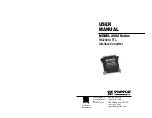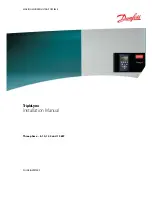
Powersine dc to ac sinewave inverters
Powersine dc to ac sinewave inverters
Powersine dc to ac sinewave inverters
Powersine dc to ac sinewave inverters
- 8 -
2.5
Connecting the load
Before you connect your appliance(s) to the inverter, always check it’s maximum power
consumption. Do not connect appliances to the inverter needing more than the nominal
power rating of the inverter continuously. Some appliances like motors or pumps, are
drawing large inrush currents in a startup situation. In these situations, it is possible that
the startup current exceeds the overcurrent trip level of the inverter. In this case the output
voltage will shortly decrease to limit the output current of the inverter. If this overcurrent
trip level is continuously exceeded, the inverter will shut down and restart within 18
seconds. In this case it is advisable to disconnect this appliance from the inverter, since it
requires to much power to be driven by this inverter. Note that at higher ambient
temperature levels, the overload capacity of the inverter is reduced.
WARNING
WHEN CONNECTING MORE THAN ONE APPLIANCE TO THE
INVERTER, IN COMBINATION WITH A COMPUTER, NOTE THAT IF
ONE OF THE APPLIANCES IS STARTING UP, IT CAN CAUSE YOUR
COMPUTER TO REBOOT DUE TO A SUDDEN VOLTAGE DROP.
CAUTION
NEVER CONNECT THE INVERTER’S OUTPUT TO THE AC
DISTRIBUTION GRID, LIKE YOUR HOUSEHOLD AC WALL OUTLET.
IT WILL PERMANENTLY DAMAGE THE INVERTER!
2.6
Activating the inverter
When all the above requirements are checked and satisfied and all connections are made,
it’s time to turn on your Powersine inverter by pushing the powerswitch in the ‘
I
’ position
(see top label for pushdirection). After a short two tone beep (except PS200-xx models),
indicating that all internal circuits are checked, the sinewave shaped output voltage is
gently rising until 230V/50Hz
±
2% (or 115V/60Hz
±
3%) is reached.
When the inverter is not supplying power to an appliance for a longer time, it’s
recommended to use the inverter in the "Auto Standby" (ASB) mode to heavily reduce the
inverter's own power consumption. In this case the power switch must be pushed in the
'
II
' position. In the ASB mode the inverter will generate a testpulse on it's output once per
second, to check if there is a load applied. When the ASB mode is activated (by
generating a reversed two tone beep, (except PS200-xx models), the indicator LED will
be continuously on for 4 seconds while the inverter outputs a continuous 230V (or 115V)
sinewave. After this 4 seconds the continuous output will change to a pulsed output,
indicated by a flashing indicator LED. When a load is connected to the inverter output (or
switched on) drawing more than approx. 5W, 12W or 15W (depending on model), the
inverter jumps to the continuous mode immediately, delivering power to the load. When
Содержание powersine 200-12
Страница 2: ......











































